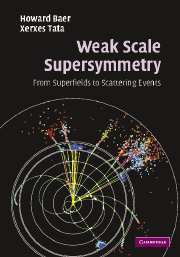Book contents
- Frontmatter
- Contents
- Preface
- 1 The Standard Model
- 2 What lies beyond the Standard Model?
- 3 The Wess–Zumino model
- 4 The supersymmetry algebra
- 5 Superfield formalism
- 6 Supersymmetric gauge theories
- 7 Supersymmetry breaking
- 8 The Minimal Supersymmetric Standard Model
- 9 Implications of the MSSM
- 10 Local supersymmetry
- 11 Realistic supersymmetric models
- 12 Sparticle production at colliders
- 13 Sparticle decays
- 14 Supersymmetric event generation
- 15 The search for supersymmetry at colliders
- 16 R-parity violation
- 17 Epilogue
- Appendix A Sparticle production cross sections
- Appendix B Sparticle decay widths
- Appendix C Higgs boson decay widths
- Bibliography
- Index
9 - Implications of the MSSM
- Frontmatter
- Contents
- Preface
- 1 The Standard Model
- 2 What lies beyond the Standard Model?
- 3 The Wess–Zumino model
- 4 The supersymmetry algebra
- 5 Superfield formalism
- 6 Supersymmetric gauge theories
- 7 Supersymmetry breaking
- 8 The Minimal Supersymmetric Standard Model
- 9 Implications of the MSSM
- 10 Local supersymmetry
- 11 Realistic supersymmetric models
- 12 Sparticle production at colliders
- 13 Sparticle decays
- 14 Supersymmetric event generation
- 15 The search for supersymmetry at colliders
- 16 R-parity violation
- 17 Epilogue
- Appendix A Sparticle production cross sections
- Appendix B Sparticle decay widths
- Appendix C Higgs boson decay widths
- Bibliography
- Index
Summary
In this chapter, we discuss various implications of the MSSM relevant to low energy experiments in particle physics and to cosmology. We will postpone examination of signals from direct production of sparticles at high energy colliders to later chapters.
In any theory (like the MSSM) with many scalar fields, there are potentially new sources of flavor-changing neutral currents (FCNC). Experiment tells us that such flavor-violating effects are strongly suppressed. Experimental constraints on these restrict the form of soft SUSY breaking masses and couplings in the MSSM. As we will discuss in more detail, viable models may be classified by the pattern (universality, alignment or decoupling) of scalar mass matrices. We also discuss constraints from potentially large CP-violating processes such as the electric dipole moment of the electron and neutron.
We then proceed to study the effects of renormalization in the MSSM, which differ from corresponding effects in the SM because of the presence of weak scale superpartners. The prediction of gauge coupling unification in the MSSM – but not in the SM – is the best known, and perhaps the most spectacular, of these differences. It is possible to view the MSSM as a theory defined at the scale MSUSY ∼ Mweak, but with > 100 additional parameters that have well-defined values at that scale. However, since the MSSM is stable against radiative corrections, it may be valid up to much larger energy scales, perhaps as high as those associated with grand unification or string phenomena. New physics at these scales may provide an organizing principle that determines the multitude of weak scale SUSY parameters in terms of a few more fundamental parameters.
- Type
- Chapter
- Information
- Weak Scale SupersymmetryFrom Superfields to Scattering Events, pp. 190 - 234Publisher: Cambridge University PressPrint publication year: 2006

